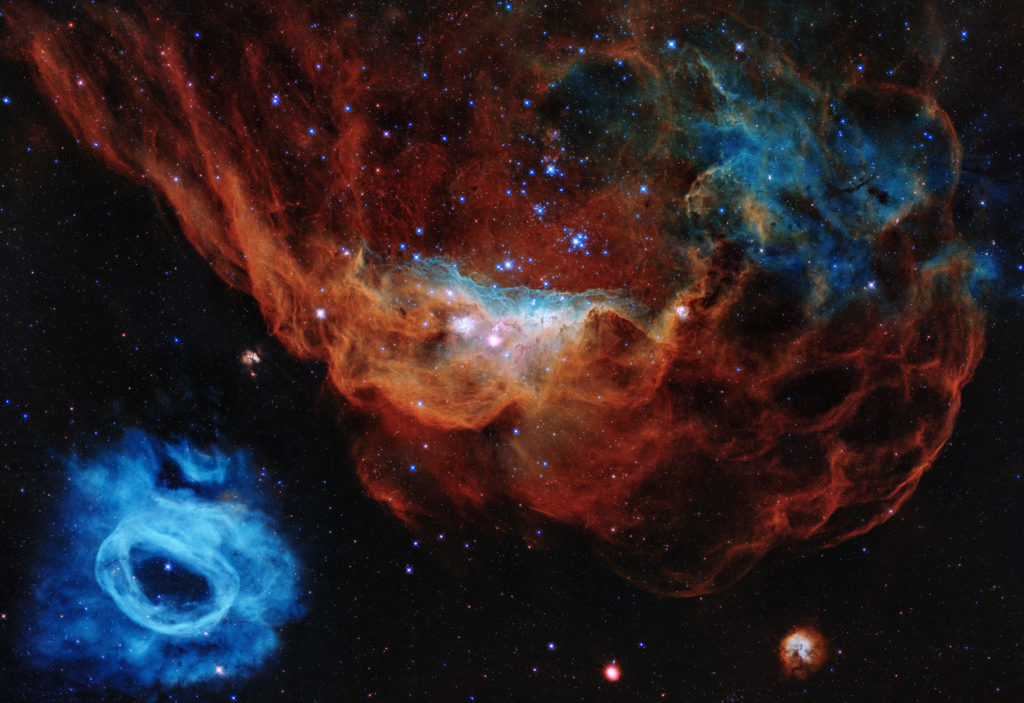Who would have expected the Hubble Space Telescope (often referred to as HST or Hubble) to still be in operation after being launched into low Earth orbit in 1990? So, NASA/ESA kickstarted its 30th anniversary with some majestic galactic photos.
Wiki:
Five Space Shuttle missions have repaired, upgraded, and replaced systems on the telescope, including all five of the main instruments. … The fifth servicing mission … was completed in 2009.
heic2002 – Photo Release > Hubble Surveys Gigantic Galaxy (6 January 2020)
To kickstart the 30th anniversary year of the NASA/ESA Hubble Space Telescope, Hubble has imaged a majestic spiral galaxy. Galaxy UGC 2885 may be the largest known in the local universe. It is 2.5 times wider than our Milky Way and contains 10 times as many stars.

See also: EarthSky.org > “New Hubble view of gigantic galaxy” posted by Eleanor Imster and Deborah Byrd (January 13, 2020)
UGC 2885 is one of the spiral galaxies studied by the famous astronomer Vera Rubin (1928–2016) in her groundbreaking research in the 1970s. … She and astronomer Kent Ford examined more than 60 spiral galaxies. They found, in every case, that stars on the outer edges of galaxies revolved around the galaxies’ centers at least as fast as those in the inner regions. That observed fact ran counter to Kepler’s Laws of Motion, formulated in the early 1600s. Kepler’s insights suggested that stars in a galaxy’s outer regions should be moving more slowly than those in its inner regions, just as the outer planets in our solar system move more slowly than the inner planets.
Astronmomers reached a dramatic conclusion about Rubin and Ford’s findings: these galaxies contain mass we cannot see. This missing mass today is called dark matter.
Additional images
HST > An Active Centre


Update April 3, 2020
YouTube > NASA Goddard > “The Hubble Space Telescope Virtual (360°) Tour” (Mar 30, 2020)
Update May 19, 2020
HST > “Hubble Celebrates its 30th Anniversary with a Tapestry of Blazing Starbirth” (24 April 2020).
Hubble Space Telescope’s iconic images and scientific breakthroughs have redefined our view of the Universe. To commemorate three decades of scientific discoveries, this image is one of the most photogenic examples of the many turbulent stellar nurseries the telescope has observed during its 30-year lifetime. The portrait features the giant nebula NGC 2014 and its neighbour NGC 2020 which together form part of a vast star-forming region in the Large Magellanic Cloud, a satellite galaxy of the Milky Way, approximately 163,000 light-years away. The image is nicknamed the “Cosmic Reef” because it resembles an undersea world.

YouTube > HubbleESA > “3D Animation of the Cosmic Reef ” (Apr 24, 2020)
Credit: NASA, ESA, G. Bacon, J. DePasquale, L. Hustak, J. Olmstead, A. Pagan, D. Player, and F. Summers (STScI). Music: “Cosmic Reef” by J. DePasquale (STScI)

See also > Space.com > “Giant ‘Rubin’s Galaxy’ stars in stunning Hubble photo named for dark matter pioneer” by Doris Elin Urrutia (January 15, 2020)
[Image (see image in post above) caption] This Hubble Space Telescope photograph features spiral galaxy UGC 2885 (Rubin’s galaxy), located 232 million light-years away in the northern constellation Perseus. The brightest star in this picture belongs to the Milky Way and is located much closer to Earth than UGC 2885. Image credit: NASA/ESA/B. Holwerda (University of Louisville).
Imagine an exposure time of over 11 days to take a single photo … staring into the sky where there’s nothing visible … empty places … the deep fields, the Ultra Deep Field … seeing how the universe has changed over thirteen billion years (of the 13.8 billion since the Big Bang) … clusters of galaxies … gravitational lensing …
• YouTube > NASA Goddard > “Episode 3: Time Machines (Hubble – Eye in the Sky miniseries)” (Jul 23, 2020)